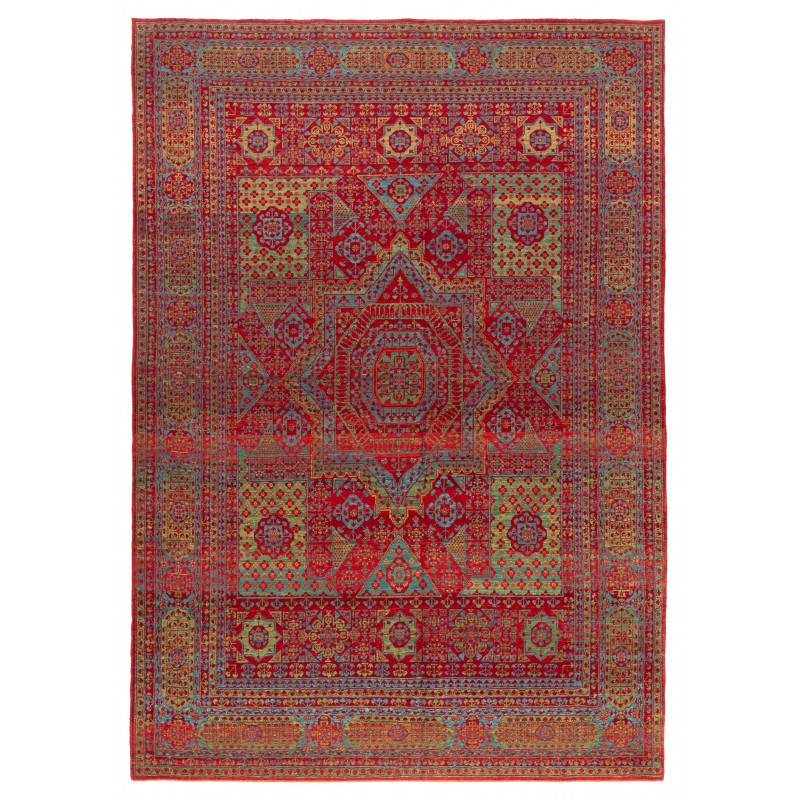
- Stock: In Stock
- Model: C40073
- サイズ: 202cm x 284cm
- SKU: ART28
マムルーク朝カイロの16世紀初頭にデザインされた中央の星を持つこの絨毯の情報源は、ワシントンD.C.のテキスタイル博物館(inv. R 16.2.4)です。この絨毯は、1926年のベンギアットセール(「ダマスカスゴシックカーペット」として知られる)でマイヤーズ氏によって入手され、1947年のシカゴ展示会で展示されました。この絨毯は通常の標準形式からの脱却を図っています。3つのメダリオンの絨毯には長さが足りず、エレムと中央のメダリオンの間のフィールドが延長されています。
カイロの工房で生産された初期の絨毯を読み解こうとすると、まったく異なる課題が生じます。カイロの絨毯は、限られた色彩のパレット、対称的な結び目、および異例のS-撚りウールの構造(イスラム世界のほとんどの地域で通常使用されるZ-撚りウールとは異なる)で特徴付けられており、オスマン帝国が1517年にマムルーク帝国を征服した後、デザイン上の急激な変化を経験しました。シモネッティカーペットは征服後に織られた可能性がありますが、マムルーク朝の15世紀の「古い」スタイルを示しています。長くて細長い形状で、標準的なエジプトのローラービーム織機で織られ、さまざまな長さの絨毯を生産することができました。この絨毯は、A-B-C-B-Aのパターンで5つの主要なデザイン領域で構成されており、第1および第5の領域と第2および第4の領域がペアになっており、中央の領域は独自のものです。これらの5つのデザイン領域をメダリオンと簡単に呼ぶことができますが、レイアウトと詳細の両方で幾何学的であり、そのスタイル(織られた実際の日付とは異なる)はメダリオン形式の絨毯のデザイン革命よりも以前のものです。マムルーク絨毯のデザインと色彩は、昆虫由来の赤、青、緑、そして時には黄色を組み合わせた独特な組み合わせで、早期の近代市場、特にヨーロッパで認識されるブランドを作り出す試みを成すものでした。このようなマムルーク絨毯は、微妙な色合い、非常に詳細なデザイン、小さな複雑な幾何学的なモチーフのモザイク状の配置など、アナトリアのより粗く織られ、鮮やかな色合いのカーペットであるウシャクメダリオンカーペットとは異なる魅力的な選択肢を提供しました。伝統的な幾何学的なマムルークデザインでの絨毯の織りは、おそらく17世紀まで続いたようですが、16世紀半ば頃から、カイロの織り手たちは、伝統的なマムルークの材料、技法、および色使いを使用しながら、イスタンブールのオスマン朝スルタンの宮廷で生み出された最新のスタイルを反映したまったく新しい種類の絨毯を作り始めました。この絨毯のデザインは、当社のデザイナーによって解釈され、柔らかい色が使用されています。
The source of the rug comes from the Textile Museum, Washington D.C. inv. R 16.2.4. This rug with the central star was designed in the early 16th-century rug by Mamluk Sultane of Cairo, Egypt. Acquired by Mr.Myers at the 1926 Benguiat Sale(“a Damascus Gothic Carpet”) and exhibited at the 1947 Chicago Exhibition, this carpet breaks with the usual standard format. Not long enough for a 3 medallion carpet, the field has been elongated between the Elem and the central medallion.
Attempting to read early carpets produced in workshops in Cairo provides an entirely different set of challenges. Cairene carpets, distinguished by their limited color palette, symmetrical knotting, and unusual construction of S-spun wool (Z-spun wool being the norm almost everywhere in the Islamic world), underwent a sudden change in design sometime after the Ottoman Turks conquered the Mamluk Empire in 1517. The Simonetti Carpet was probably woven after the conquest but exhibits the “old” fifteenth-century style of the Mamluks. Long and narrow, it was woven on a standard-sized Egyptian roller-beam loom, capable of producing carpets of varying lengths. It consists of five major focal areas of design in an A-B-C-B-A pattern, meaning the first and fifth and the second and fourth areas are paired, while the middle is unique. We can easily term these five focal areas medallions, but they are geometric in both layout and detail, and their style (as opposed to the actual date of the weaving) predates the carpet design revolution that gave rise to the medallion format. We can surmise that the designs and colors of Mamluk carpets, with their unusual combination of insect-derived red, blue, green, and sometimes yellow, with virtually no undyed white at all, constitute an effort to create a recognizable brand in the early modern market, especially in Europe, where Mamluk carpets such as this, with their subtle coloration, incredibly detailed design, and mosaic-like layout of small and intricately patterned geometric motifs, constituted an appealing alternative to the more coarsely woven and brightly colored carpets from Anatolia, such as Ushak medallion carpets. While the weaving of carpets in the traditional geometric Mamluk designs apparently continued well into the seventeenth century, sometime around the mid-sixteenth century, Cairene weavers began to create an entirely new kind of carpet, using their traditional Mamluk materials, technique, and coloration but reflecting the latest styles then being created at the court of the Ottoman sultans in Istanbul. The design of the rug is interpreted by our designers, and soft colors are used for this rug.
